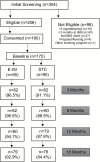Cigarette Smoking Cessation Intervention for Buprenorphine Treatment Patients
- PMID: 28549161
- PMCID: PMC7207071
- DOI: 10.1093/ntr/ntx113
Cigarette Smoking Cessation Intervention for Buprenorphine Treatment Patients
Abstract
Introduction: Patients receiving medication assisted therapy (MAT) for opioid use disorder have high cigarette smoking rates. Cigarette smoking interventions have had limited success. We evaluated an intervention to increase cigarette abstinence rates in patients receiving buprenorphine-assisted therapy.
Methods: Cigarette smokers (N = 175; 78% male; 69% Caucasian; 20% Hispanic), recruited from a buprenorphine clinic were randomly assigned to either an extended innovative system intervention (E-ISI) or to Standard Treatment Control (STC). The E-ISI combined motivational intervention with extended treatment (long-term nicotine replacement therapy , varenicline, and extended cognitive behavioral therapy). STC received written information about quit-lines, medication, and resources. Assessments were held at baseline and 3, 6, 12, and 18 months. Seven-day biochemically verified point-prevalence cigarette abstinence was the primary outcome measure.
Results: Fifty-four percent of E-ISI participants entered the extended treatment intervention; E-ISI and STC differed at 3 months on abstinence status but not at months 6, 12, and 18. E-ISI participants were more likely to attempt to quit, to have a goal of complete abstinence, and to be in a more advanced stage of change than STC participants. A higher number of cigarettes smoked and the use of cannabis in the previous 30 days predicted continued smoking.
Conclusions: The E-ISI was successful in increasing motivation to quit smoking but did not result in long-term abstinence. The failure of treatments that have been efficacious in the general population to produce abstinence in patients receiving MAT of opioid use disorder suggests that harm reduction and other innovative interventions should be explored.
Implications: This study demonstrates that an intervention combining motivational interviewing with an extended treatment protocol can increase cigarette quit attempts, enhance cigarette abstinence goals, and further movement through stages of change about quitting smoking in patients receiving MAT for opioid use disorder who smoke cigarettes. The intervention did not increase abstinence rates over those observed in a standard treatment control, however. The latter finding supports those of earlier investigators who also failed to find efficacy for smoking cessation in this population and who also used interventions effective in the general population. This pattern of findings suggests that patients with opioid use disorder can be motivated to change smoking behavior, but alternative and innovative approaches to cigarette smoking treatment should be studied.
Trial registration: ClinicalTrials.gov NCT01350011.
Figures
References
-
- Nahvi S,Richter K,Li X,Modali L,Arnsten J. Cigarette smoking and interest in quitting in methadone maintenance patients.Addict Behav.2006;31(11):2127–2134. - PubMed
-
- Clemmey P,Brooner R,Chutuape MA,Kidorf M,Stitzer M. Smoking habits and attitudes in a methadone maintenance treatment population.Drug Alcohol Depend.1997;44(2-3):123–132. - PubMed
-
- Richter KP,Gibson CA,Ahluwalia JS,Schmelzle KH. Tobacco use and quit attempts among methadone maintenance clients.Am J Public Health.2001;91(2):296–299. - PMC - PubMed
Publication types
MeSH terms
Substances
Associated data
Grants and funding
LinkOut - more resources
Full Text Sources
Other Literature Sources
Medical


